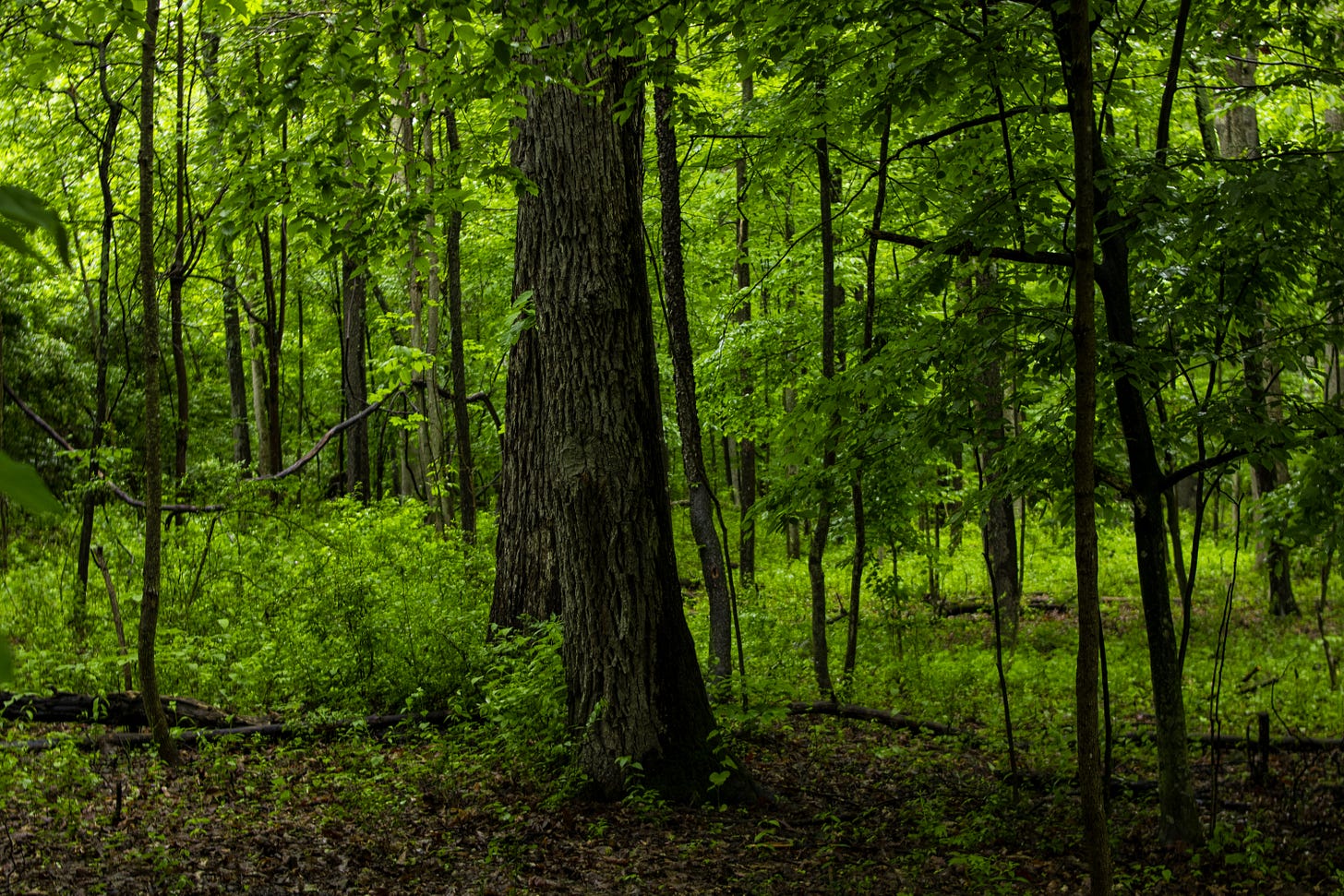Mapping Forest Meaning In The Time of Destruction
What is a forest? There's an ecological definition that we could use–including things like species presence, providing habitat, tree cover percentages, and so forth–but this doesn't feel sufficient to describe the myriad of ways that people connect to forests. Even on the smallest scale, you couldn't substitute the tree you climbed in your backyard as a kid for the tree in someone else's yard simply because they're both maples. One has a specific meaning to you, one does not. Likewise, a forest in one place does not mean the same thing to the people who live in or near it as a forest somewhere else. These meanings are contextual, and amidst the current ecological destruction of our planet, they become crucial hinges on which forest fates turn.
For example, in 2016, Indianapolis residents mobilized around the potential development of an urban forest, known as Crown Hill Woods, near the downtown area of the city. The owner of Crown Hill Woods - Crown Hill Cemetery - attempted to sell it to the Department of Veteran Affairs, which planned to cut the urban forest to construct a columbarium. Upon realizing this, community members mobilized around the protection of the forest in what eventually became a year-long struggle over the fate of the forest.
The activists protesting the forest's destruction used a variety of tactics, from climbing trees when construction equipment arrived to publishing blog and news articles to writing letters to elected officials. What we can see from their actions, and the language they used to describe the forest they protected, is what the forest meant to them, how they defined it.
A few years ago a colleague and I published a paper about this after we analyzed many of the articles, blog posts, and social media posts centered around this struggle. What we found is that the activists defined the forest in terms of its material components, like the size and presence of the trees, but also in terms of the non-human agency the trees exhibited through their presence, the ethical dimensions of removing them, and the fact that the trees invited interactions with the past at the site via their longevity.
These definitions reveal unique place attachments, and place meanings, such that the forest was irreplaceable to the community. And ultimately their struggle was successful. Crown Hill Cemetery and the Department of Veteran Affairs backed away from the sale of Crown Hill Woods and changed their plans for the forest.
Atlanta's Stop Cop City movement bears many similarities to the conservation activism in Indianapolis, but differs in its scale, as well as the stakes. After a long history of social disinvestment and abandonment in the city, social unrest culminated in 2020 with massive protests following the murders of George Floyd and Rayshard Brooks by police officers.
The city government's response to this was to construct a large police training center to conduct urban warfare style police training. The site they chose to build this on was the South River Forest, later renamed to Weelaunee Forest. The facility was dubbed "Cop City" by those who mobilized around the protection of Weelaunee Forest. Two recent books (No Cop City, No Cop World and Beyond Cop Cities) chronicle their struggle.
What we see in the writing and other discourse from the activists is that the forest took on similarly distinct meanings as in Crown Hill Woods. They held religious ceremonies in the forest that reveal the sacred meanings the trees took on, while at the same time transformed the forest into a symbol of resistance to police oppression.
The activists used similar tactics as those in Indianapolis, but also went further in their resistance. They built permanent tree houses, sabotaged construction equipment, and ran a robust signature-gathering campaign in order to put the fate of Weelaunee Forest in the hands of Atlanta residents. Unlike in Indianapolis though, the movement was not able to stop the destruction of the forest nor the construction of Cop City. They did, however, reveal the ways that police are deployed as weapons of capital, rather than protectors of communities. The fact that Weelaunee Forest took on a symbol of popular resistance meant that it had to be destroyed by those holding power, and by doing so, those powerful elites laid bare their willingness to engage in community oppression.
These struggles over forest meanings are certainly not unique to the United States. In the Ecuadorian Amazon, mining frontiers have expanded over the last 20 years under government-corporation frameworks of extraction. A recent paper Latin American and Caribbean Ethnic Studies examines the ways that settler logics of capitalism in the Amazon seek to replace the Indigenous forest relations with those that suit their wealth-extraction intentions.
Indigenous communities, particularly female Kichwa members, deploy storytelling as a way to both define the forest and to understand conflicts with mining operations. Furthermore, these women put forth the idea of the Living Forest, or Kawsak Sacha, as a framework for guiding forest management within worldviews that are in contrast with traditionally Western values that emphasize production. Corporate greenwashing often co-opts Indigenous ideas like the Living Forest to feign cooperation with local communities while they extract resources and destroy the environment.
Through storytelling, Kichwa women explain their relationships to the forest, and forest spirits, in order to inform their own decision-making and organizing. In doing so, storytelling becomes a method of environmental justice, resistance to capitalism, and of defining the forest as a place with specific place meanings. Kichwa women strategically used these storytelling methods during National Assemblies to exert their own agency over their forest and have a say in its fate. In the paper linked above, their storytelling is legitimized as an alternative framework through which the community wants to organize forest management.
Every forest has a different meaning, and these meanings are almost always contested by various groups with contrasting interests. But collectively, what these examples show is that the place-meanings that forests take on motivate people to act to conserve them. While scientists often use languages of quantification–how much pollution do the trees remove, how much carbon do they store, how much fresh water do they provide–it is often languages of meaning that are central to community and activist movements.
Attachments to places are how we make sense of the world around us. When these places are threatened, so too are our own places within the world.





Have you read Pedagogy of the Oppressed by Paulo Friere? It’s closely linked to what you talk about in this essay, and I’ve been finding many examples lately of communities using storytelling or poetry to ‘talk back’. It’s lovely work.
Forests are living beings, thanks for collating and writing about them so passionately!
You've made such an important distinction between the quantification, "ecosystem services" approach to valuing forests and that of simple emotional attachment, especially place based. I've always hated the term ecosystem services, as if landscapes exist to serve us. It's a dead end, and you are pointing the way toward living beginnings. Thanks.